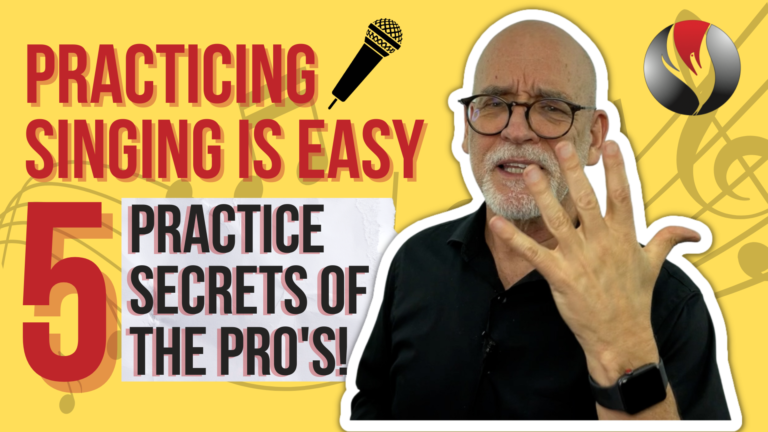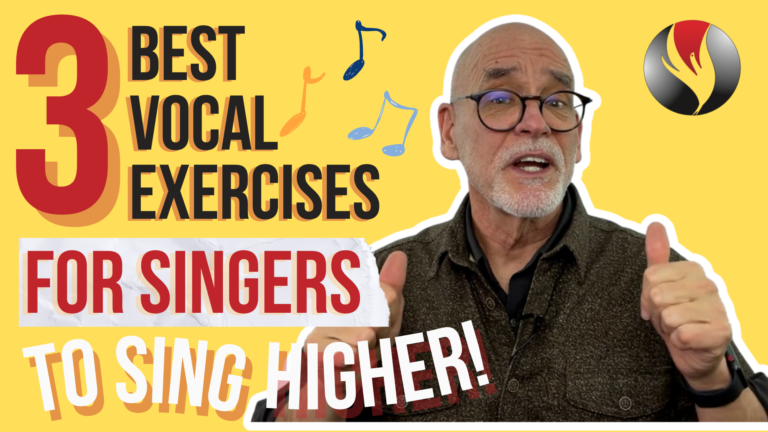Singing Higher really is easier than you think. Today’s tip is about not singing so loud, especially when you’re learning to get into your head voice. Can it be that simple? Watch and find out!
OK, so maybe there’s a little more to it than just reducing the loudness. If you’ve watched the 4 previous episodes and have started doing the first 4 tips, this tip #5 will help the others work even better.
Singing Higher is Easier than You Think – Tip# 5 of 5
When first learning to sing higher into the first bridge of the voice, decrease the volume. By decreasing the loudness you help yourself at least 2 ways. Softer volume means:
1. Less air blow, air pressure and vocal weight when singing higher
2. Easier transition between head voice and chest voice
Less Air Blow and Pressure
Let’s talk about less air blow and pressure. By singing softer, you reduce the amount of air from your lungs to the vocal cords. There’s not as much air that your vocal cords has to hold back. This reduces the external muscle tension in your throat and neck. [Demo]
Also when you reduce the loudness, the vocal cords have less air pressure leaning against them. The vocal cords don’t have to be held together so firmly because there’s not as much pressure pushing against them. This allows the vocal cords to adjust easier between pitches. It’s the difference between lifting 40 lb. vs 10 lb. dumbbells. It’s just easier because it takes less muscle, less force, less vocal cord mass and weight.
This makes it easier to transition into head and and back down to chest voice.
A common mistake we make is we think the pressure we feel with the louder volume and tension is the same thing as vocal power. In reality, if the vocal cords were not so labored by the excess muscle needed to sing loud, the vocal cords could develop the intrinsic strength to produce power and freedom of sound with a vocal release perhaps you’ve never experienced.
This takes some time and patience to develop and trust a new vocal feeling and coordination. It begins with not pushing so much air and singing too loud.
Easier Transitions
The louder voice and the thicker, heavier vocal cords means the transition from chest to head must be more abrupt.
Singing loud can be compared it to going up steps where each step is too high. The next step is so far up that you have to raise your leg and foot so high that you can barely get to the next step. Then you have to have enough strength in one leg to lift all your weight to the next higher step.
Singing loud often requires lifting a lot of vocal weight upward. It’s heavy and get’s louder as you go higher.
When singing loud going back down is just as hard and awkward. It feels like you have to jump and clunk down from step to step from head voice into chest voice.
Singing softer with less tension and thickness in the vocal cords makes transitioning into head and back to chest voice easier. Instead of steps, it’s a gentle ramp and you glide easily back and forth between head and chest voice.
I’m not saying you should always sing softer. But when you’re learning to sing higher from chest voice, through the First Bridge and into head voice and back down into chest, reducing the volume will make it easier.
Utilizing the other tips will also help you keep the larynx down and the vocal cords connected. Combining these with reducing the volume gives you the formula for successfully singing higher.
These 5 tips will help your singing higher into and through the first bridge without pulling chest voice or hiking the larynx upward. You’ll be able to do it without cracking or flipping into falsetto. You’ll do it with strength and power in your voice. You will do it with a mix of chest and head voice.
Mix is also a vocal type. Do you know your vocal type? Do you know what you tend to do when you sing into and through the First Bridge of your voice?
Visit PowerToSing.com and take the vocal test which I call the PowerTest. You’ll see it on the Home Page. Take the quiz and discover your vocal type. Then visit the Knowledge Center and watch the videos about your vocal type.
Download the free exercises designed specifically for your vocal type and start improving your voice immediately.
I’m Chuck Gilmore with Power To Sing. You can sing higher with beauty, confidence and power.
I’ll see you inside the next video.










Responses